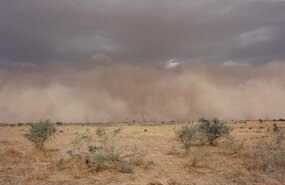G. Bergametti1, B. Marticorena1, J. L. Rajot1,2, B. Chatenet1, A. Féron1, C. Gaimoz1, G. Siour1,
M. Coulibaly3, I. Koné3, A. Maman4, and A. Zakou4
1Laboratoire Interuniversitaire des Systèmes Atmosphériques (LISA), UMR CNRS 7583, Université Paris-Est Créteil and Université Paris-Diderot, Institut Pierre-Simon Laplace (IPSL), Paris, France
2Institut d’Ecologie et des Sciences de l’Environnement de Paris (iEES Paris), UMR IRD 242, Université Pierre et Marie Curie - CNRS - INRA - Université Paris Est Créteil -Université Paris Diderot, Paris, France
3Institut d’Economie Rurale (IER), Station de Recherche Agronomique de Cinzana, Bamako, Mali
4IRD-Niamey, Institut de Recherche pour le Développement (IRD), Niamey, Niger
About 2000 Tg of mineral dust are injected yearly into the atmosphere, making dust as one of the most emitted particulate species. As a consequence, the dust cycle has significant impacts on the Earth environment. In the source regions, mainly the arid and semi-arid regions, the movement of soils erodible by wind modulates the geomorphology of the landscape but can also lead to an impoverishment of grasslands and cultivated soils. During their transport in the atmosphere, the finest component of dust can interact with solar and terrestrial radiations, changing regionally and temporarily the Earth radiative budget. Mineral dust could also act in the formation of clouds, especially as ice nuclei or modify their microphysical and optical properties. In deposition areas, dust provides terrestrial and oceanic ecosystems with nutrients such as iron or phosphorus.
The main processes controlling the dust cycle on Earth are very sensitive to meteorological parameters such as surface wind speed or precipitation. Thus, it is suspected that the climate change could significantly modify the atmospheric dust content in the future, especially by changing the intensity and location of dust emissions. The semi-arid regions, as climatic transitional regions, should be particularly affected. Indeed, in these regions, the expected changes should concern not only the meteorological parameters that directly drive dust emission but also those controlling the vegetation cover as precipitation and evapo-transpiration. Moreover, contrary to desert areas, the fringes of the arid regions are inhabited, with a population density growing rapidly. As a consequence, land use activities should intensify in the future to provide the food necessary to support this expanding population. Among these semi-arid regions, the Sahelian belt is suspected to be one of the areas where significant changes in dust emissions could occur in the future and where the processes acting on dust emission are the most complex to account for.
Our group works on dust emission from the Sahel since 2006 first through the AMMA ((African Monsoon Multidisciplinary Approach), the ANR project CAVIARS and the SNO INDAAF. We will illustrate the main results obtained these last years, especially those resulting from the continuous measurements performed during 10 years in the framework of INDAAF.


